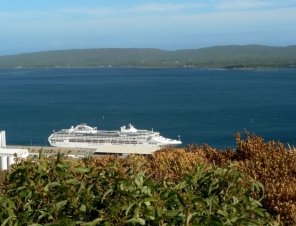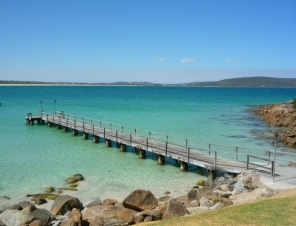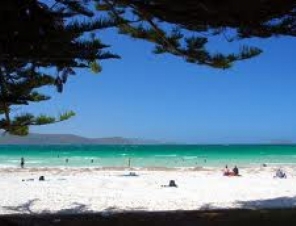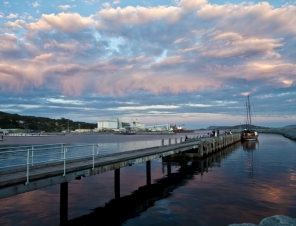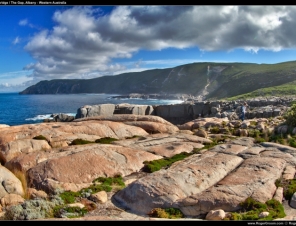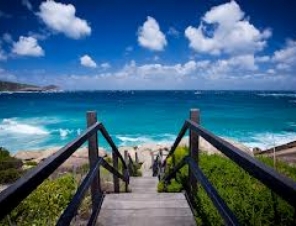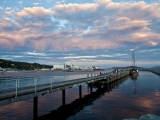Albany is a port city in the Great Southern region of Western Australia, some 418 km SE of Perth, the state capital. With a population of 35,000 it is the sixth-largest city in the state.
The city centre is at the northern edge of Princess Royal Harbour, which is a part of King George Sound. The Central Business District is bounded by Mount Clarence to the east and Mount Melville to the west.
Albany was founded in January 1827 as a military outpost of New South Wales as part of a plan to forestall French ambitions in the region. The area was initially named Frederickstown in honour of Prince Frederick, Duke of York and Albany. In 1831, the settlement was transferred to the control of the Swan River Colony and renamed Albany by Governor James Stirling.
During the late 19th and early 20th centuries, the town served as a gateway to the Eastern Goldfields and, for many years, it was the colony's only deep-water port, having a place of eminence on shipping services between Britain and its Australian colonies. The construction of Fremantle Harbour in 1893, however, saw its importance as a port decline, after which the town's industries turned primarily to agriculture, timber and, later, whaling.
Today the town is a place of significance as a tourist destination and base from which to explore the south-west of the state and is well regarded for its natural beauty and preservation of heritage. Albany has an important role in the ANZAC legend, being the last port of call for troopships departing Australia in the First World War.
The city is also the oldest permanently settled town in Western Australia, predating Perth and Fremantle by some two years and is the oldest continuous European settlement in Western Australia, founded in 1826. The King George Sound settlement was a hastily dispatched British military outpost, intended to forestall any plans by France for settlements in Western Australia.
The Albany region was first home to the Menang Noongar people, who made use of the area during the summer months for fishing and other activities. They called the area Kinjarling which means "the place of rain". Many town names in South-Western Australia end in "up" or "ing", which means "place of" in the Noongar language.
Early European explorers discovered evidence of fish traps located on Emu Point and on French, now Kalgan, River and a small "village" of bark dwellings that were, at the time, deserted.
The first European explorers to visit the area around Albany were on the Dutch ship Gulden Zeepaert (Golden Seahorse) skippered by Francois Thijssen in 1627. They sailed along the south coast towards South Australia. In 1791, English explorer George Vancouver explored the south coast including entering and naming King George Sound. Albany was the site at which, on 27 September 1791, Vancouver took possession of New Holland for the British Crown. Vancouver went out of his way to establish good relationships with the local Aboriginal people.
In 1792, Frenchman Bruni d'Entrecasteaux, in charge of the Recherche and L'Esperance, reached Cape Leeuwin on 5 December and explored eastward along the southern coast. The expedition did not enter King George Sound due to bad weather. In 1801, Matthew Flinders entered King George Sound and stayed for about a month before charting the rest of the southern Australian coastline. By 1806 he had completed the first circumnavigation of Australia.
On 7 March 1831 the King George Sound and colony was made part of the Swan River Colony and a free settlement. Albany was officially named by Governor Stirling at the beginning of 1832, at the time that political authority passed to the Swan River colony.
The main industries of Albany consist of tourism, fishing, wood chips and agriculture, although before the 1950s whaling was one of the major sources of income and employment for the population.
The Whaling Station, which closed operations in 1978, has now been converted into a museum of whaling, and features one of the 'Cheynes' whale chasers that were used for whaling in Albany. The station was the last operating whaling station in the Southern Hemisphere and the English-speaking world at its time of closing.
The Western Power Wind Farm in Albany is the largest and newest in Australia, except for the new turbines in nearby Mount Barker and Denmark. Its 12 turbines, driven by strong southerly winds, can generate up to 75% of the city's electricity usage.
Albany also has a number of historic tourist sites including the Museum, Albany Convict Gaol, The Princess Royal Fortress (commonly known as The Forts), Patrick Taylor Cottage, ("is the oldest dwelling in Western Australia, c1832").
Natural sights are also numerous, especially the rugged coastline, which includes the Natural Bridge and the Gap. The beaches have pristine white sand. The destroyer HMAS Perth was sunk in King George Sound in 2001 as a dive wreck. Albany is also close to two low mountain ranges, the Porongurups and Stirling Ranges and is the southern terminus of the Bibbulmun Track walking trail.
Albany has a Mediterranean climate, with dry, warm summers; cool, wet winters and very pleasant springs and autumns in between. Summers sometimes have short spells of very hot weather, but the Ocean cool breeze brings relief in, specially during evenings and nights. The city is situated on what is promoted as the "Rainbow Coast" which is an appropriate title given the significant frequency of days with both sun and drizzle or showers.
July is the wettest month and the driest is February, in summer, it rains on average about one day in every four.
How close to the city is the cruise terminal.
Its about 2km to the city centre from the cruise berth.

 |
|





